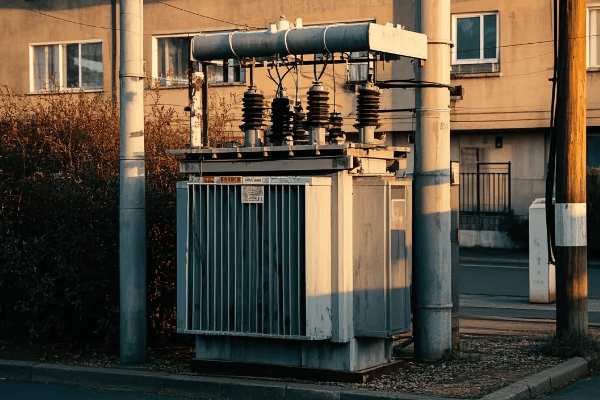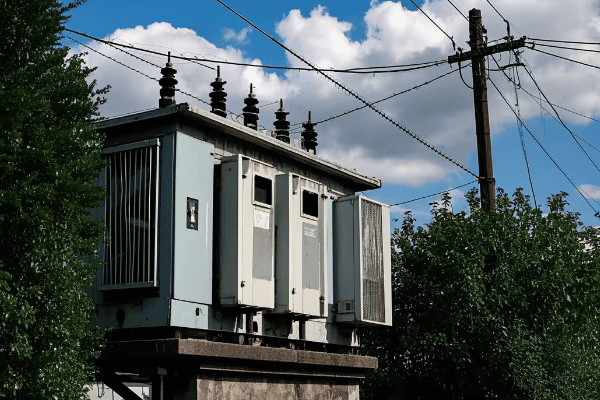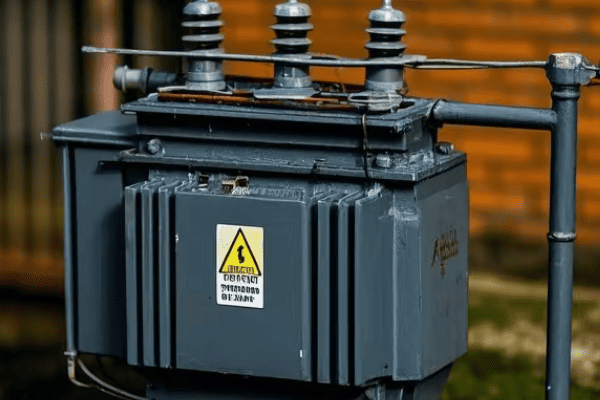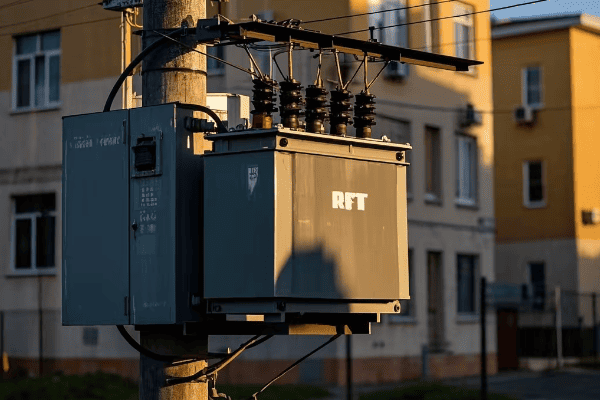What Is an Electric Transformer: The Unsung Hero of Power Distribution?
Have you ever wondered how electricity travels safely from power plants to your home? The answer lies in a device you rarely see but heavily rely on: the electric transformer.
An electric transformer is a device that changes the voltage of electrical power. It allows electricity to be transmitted efficiently over long distances and then safely used in our homes and businesses. Transformers are the unsung heroes that make our modern electrical grid possible.

As an electrical engineer with years of experience in the power industry, I’ve seen firsthand how crucial these devices are. Let’s explore the world of electric transformers and discover why they’re so important for our modern life.
The Inner Workings of Electric Transformers: Powering Our World Behind the Scenes?
Imagine trying to pour water from a fire hose into a drinking glass. That’s similar to the challenge of getting electricity from power plants to your home. Transformers are the solution to this problem.
Electric transformers work by using electromagnetic induction to change voltage levels. They have two coils of wire around an iron core. When alternating current flows through one coil, it creates a changing magnetic field that induces a voltage in the other coil.

Let’s dive deeper into how transformers work:
The Principle of Electromagnetic Induction
This is the key to transformer operation:
- An alternating current in the primary coil creates a changing magnetic field.
- This field is concentrated by the iron core.
- The changing field induces a voltage in the secondary coil.
- The voltage in the secondary coil depends on the ratio of turns in the two coils.
Voltage Transformation
Transformers can increase or decrease voltage:
- If the secondary coil has more turns than the primary, voltage increases.
- If it has fewer turns, voltage decreases.
- The voltage ratio equals the turns ratio.
The Role of the Core
The iron core is crucial for efficient operation:
- It provides a low-reluctance path for the magnetic field.
- This concentrates the field, making the transformer more efficient.
- The core is made of thin laminations to reduce energy losses.
Here’s a simple comparison of transformers with different turn ratios:
| Primary Turns | Secondary Turns | Input Voltage | Output Voltage | Type |
|---|---|---|---|---|
| 100 | 1000 | 120 V | 1200 V | Step-up |
| 1000 | 100 | 12000 V | 1200 V | Step-down |
| 100 | 100 | 120 V | 120 V | Isolation |
I remember the first time I saw a large power transformer in action. The hum of the core, the heat from the windings, and the sheer size of the device were impressive. But what struck me most was how this massive machine was silently and efficiently changing voltage levels, enabling power to flow from the plant to homes miles away.
Understanding the inner workings of transformers helps us appreciate their crucial role in our power systems. They’re not just simple devices; they’re marvels of engineering that make our modern electrical world possible. From the massive transformers at power plants to the small ones on utility poles, they all work on the same principles to keep our lights on and our devices running.
Anatomy of a Hero: Key Components That Make Electric Transformers Tick?
Have you ever opened up a device to see how it works? While I don’t recommend doing this with a transformer, understanding its components is key to grasping its function.
Electric transformers consist of several key components: the core, primary and secondary windings, insulation, and cooling system. Each part plays a crucial role in the transformer’s operation, working together to efficiently change voltage levels and transfer power.

Let’s break down the anatomy of a transformer:
1. The Core
The core is the heart of the transformer:
- It’s usually made of thin layers of silicon steel.
- These layers, called laminations, reduce energy losses.
- The core provides a path for the magnetic field.
2. Windings
Transformers have two sets of windings:
- Primary Winding: Connects to the input power source.
- Secondary Winding: Delivers the output power.
- The ratio of turns in these windings determines the voltage change.
3. Insulation
Insulation is crucial for safety and efficiency:
- It prevents short circuits between windings and the core.
- Common insulation materials include paper, oil, and resin.
4. Cooling System
Transformers generate heat, so cooling is essential:
- Small transformers often use air cooling.
- Larger ones use oil for both cooling and insulation.
5. Tap Changer
Some transformers have tap changers:
- These adjust the turn ratio slightly.
- They help maintain consistent output voltage.
Here’s a table summarizing the key components:
| Component | Function | Material |
|---|---|---|
| Core | Provides magnetic path | Silicon steel laminations |
| Primary Winding | Receives input power | Copper or aluminum wire |
| Secondary Winding | Delivers output power | Copper or aluminum wire |
| Insulation | Prevents short circuits | Paper, oil, resin |
| Cooling System | Manages heat | Air or oil |
| Tap Changer | Adjusts voltage ratio | Mechanical or electronic switch |
I once had the opportunity to disassemble a small distribution transformer during a training session. The precision of each component was impressive. The tightly wound coils, the carefully stacked core laminations, and the intricate insulation system all worked together in perfect harmony. It gave me a new appreciation for the engineering that goes into these devices.
Understanding the anatomy of a transformer is crucial for anyone working in the power industry. Each component plays a vital role, and they all must work together flawlessly to ensure reliable power distribution. From the core that channels the magnetic field to the cooling system that keeps everything running smoothly, every part contributes to the transformer’s ability to power our world efficiently and safely.
Efficiency Masters: How Transformers Optimize Power Distribution Networks?
Have you ever wondered how electricity travels hundreds of miles without losing all its power? The secret lies in the efficiency of transformers, the unsung heroes of our power grids.
Transformers optimize power distribution networks by minimizing energy losses during transmission and distribution. They do this by changing voltage levels, allowing power to be transmitted at high voltages and low currents, which reduces power loss. Transformers also help regulate voltage and balance loads across the network.
Let’s explore how transformers keep our power grids running efficiently:
1. Minimizing Transmission Losses
Transformers play a key role in reducing power losses during transmission:
- They step up voltage at power plants, reducing current for the same power.
- Lower current means lower I²R losses in transmission lines.
- This allows power to be transmitted efficiently over long distances.
2. Voltage Regulation
Transformers help maintain stable voltage levels throughout the grid:
- They use tap changers to adjust voltage ratios.
- This helps compensate for voltage drops along transmission lines.
- Stable voltage is crucial for the proper operation of electrical equipment.
3. Load Balancing
Transformers help balance loads across the power system:
- Distribution transformers can be sized and placed to match local power demands.
- This helps prevent overloading of certain parts of the grid.
4. Reducing Harmonics
Some specialized transformers can help reduce harmonic distortions in the power system:
- Harmonics can cause overheating and reduced efficiency.
- Transformers with special winding configurations can mitigate these issues.
Here’s a table showing how transformers improve efficiency at different stages:
| Stage | Transformer Type | Efficiency Improvement |
|---|---|---|
| Generation | Step-Up | Enables high-voltage transmission |
| Transmission | Power | Minimizes line losses |
| Sub-transmission | Step-Down | Prepares for local distribution |
| Distribution | Distribution | Matches voltage to consumer needs |
I once worked on a project to upgrade a city’s aging transformer network. We replaced old, inefficient transformers with modern, high-efficiency units. The results were striking. Overall power losses in the distribution system dropped by 15%, which translated to significant energy savings and reduced carbon emissions. It was a clear demonstration of how crucial efficient transformers are to our power infrastructure.
Transformers are more than just voltage converters. They’re the key to making our vast power grids work efficiently. By minimizing losses, regulating voltage, and enabling load balancing, transformers ensure that the electricity generated at power plants reaches consumers with minimal waste. As we continue to modernize and expand our power grids, the role of efficient transformers will only become more critical in ensuring reliable and sustainable power for all.
From Substations to Streetlights: The Diverse Family of Electric Transformers?
Have you ever noticed those cylindrical objects on utility poles or those large green boxes in your neighborhood? These are all different types of transformers, each with a specific job in our power distribution system.
Electric transformers come in various types, each designed for specific roles in power distribution. The main categories include power transformers for high-voltage transmission, distribution transformers for local power delivery, and special-purpose transformers for unique applications. Each type is crucial for efficient and safe power delivery.

Let’s explore the diverse family of electric transformers:
1. Power Transformers
These are the giants of the transformer world:
- Used in power plants and major substations.
- Handle very high voltages, often above 100,000 volts.
- Can be as large as a small house and weigh hundreds of tons.
2. Distribution Transformers
These bring power to our neighborhoods:
- Found on utility poles or in ground-level boxes.
- Reduce voltage to levels safe for homes and businesses (typically 120/240 volts).
- Range in size from small pole-mounted units to larger pad-mounted transformers.
3. Instrument Transformers
These help with measuring and protecting the power system:
- Current Transformers (CTs): Measure electric current.
- Voltage Transformers (VTs): Measure voltage.
- Provide inputs for meters, relays, and other instruments.
4. Special-Purpose Transformers
These are designed for specific applications:
- Isolation Transformers: Provide electrical isolation for safety or noise reduction.
- Autotransformers: Used for small voltage adjustments.
- Rectifier Transformers: Used in high-voltage direct current (HVDC) transmission systems.
Here’s a comparison of the main transformer types:
| Type | Size | Voltage Range | Primary Use |
|---|---|---|---|
| Power | Very Large | 100kV – 1000kV+ | Transmission substations |
| Distribution | Small to Medium | 4kV – 35kV | Local power distribution |
| Instrument | Very Small | Varies | Measurement and protection |
| Special-Purpose | Varies | Varies | Specific applications |
I once worked on a project that involved almost every type of transformer mentioned above. We were upgrading a small town’s electrical infrastructure. The project included a large power transformer at the local substation, numerous distribution transformers throughout the town, and instrument transformers for the new smart metering system. We even used isolation transformers for some sensitive industrial equipment. It was like conducting an orchestra, with each transformer playing its unique part in the symphony of power distribution.
Understanding these different types of transformers is crucial for anyone involved in electrical systems. Each type has its strengths and ideal applications. By using the right transformer for each job, we ensure that our power grid remains efficient, safe, and reliable. From the massive transformers at power plants to the small ones powering your electronic devices, each plays a vital role in bringing electricity to our fingertips.
Evolution of Power: How Electric Transformers Have Adapted to Modern Energy Demands?
Remember when phones were just for calling? Now they’re smart devices that do almost everything. The same revolution is happening with transformers, and it’s changing our power grid.
Electric transformers have evolved significantly to meet modern energy demands. They’ve become more efficient, smarter, and adaptable to new energy sources. Modern transformers incorporate advanced materials, digital monitoring systems, and designs that support renewable energy integration and smart grid technologies.

Let’s explore how transformers have adapted to our changing energy landscape:
1. Improved Efficiency
Modern transformers are much more efficient than their predecessors:
- They use advanced core materials like amorphous metals to reduce energy losses.
- Improved winding designs minimize copper losses.
- Some transformers now achieve efficiency ratings over 99%.
2. Smart Monitoring Systems
Transformers are getting smarter:
- They now incorporate sensors to monitor temperature, oil condition, and load.
- These systems can predict potential failures before they occur.
- This enables predictive maintenance, reducing downtime and extending transformer life.
3. Adaptability for Renewable Energy
Transformers have evolved to support renewable energy integration:
- They can handle bidirectional power flow from distributed generation sources.
- Some are designed to cope with the variable output of wind and solar power.
- Special designs help manage harmonics introduced by renewable energy inverters.
4. Size and Weight Reduction
Modern transformers are often smaller and lighter:
- This makes installation and replacement easier, especially in urban areas.
- It also reduces transportation costs and environmental impact.
Here’s a comparison of traditional and modern transformers:
| Feature | Traditional Transformer | Modern Transformer |
|---|---|---|
| Core Material | Silicon Steel | Amorphous Metal or Advanced Silicon Steel |
| Monitoring | Basic gauges | Integrated digital monitoring systems |
| Renewable Energy Compatibility | Limited | Designed for bidirectional power flow |
| Efficiency | 95-98% | Up to 99.5% |
| Size/Weight | Larger and heavier | Compact and lighter |
I recently worked on a project to replace an old substation transformer with a modern unit. The new transformer was 30% smaller but had the same power rating. It came with an advanced monitoring system that could predict potential issues weeks in advance. The utility company was amazed at how much more they could do with this single unit. It was a clear example of how far transformer technology has come.
The evolution of transformers is not just about incremental improvements. It’s about reimagining how our power grid works. These advancements are enabling a more flexible, efficient, and reliable power system. They’re helping us integrate more renewable energy, reduce energy losses, and create smarter grids. As we continue to face new energy challenges, transformers will keep evolving, playing a crucial role in shaping the future of our power systems.
Conclusion
Electric transformers are the unsung heroes of power distribution. They efficiently change voltage levels, enable long-distance transmission, and adapt to modern energy demands. From massive substation units to small pole-mounted devices, transformers are crucial in powering our world reliably and safely.
Free CHBEB Transformer Catalog Download
Get the full range of CHBEB transformers in one catalog.
Includes oil-immersed, dry-type, pad-mounted, and custom solutions.
Quick Message
Request A free quote
We'd like to work with you
- +86 15558785111
- [email protected]
- +86 15558785111
What We Do
CHINA BEI ER BIAN (CHBEB) GROUP, with 218 million in registered capital, originated from Beijing Beierbian Transformer Group. Headquartered in Beijing for R&D, it operates major production bases in Nanjing and Yueqing, producing high-quality products.
Latest Product
address
BeiJing
No 3,RongJing East Road,BeiJing Economic Technological Development Area,BeiJing,China
JiangSu
No 7️Xiangfeng Road,Jiangning,NanJing,JiangSu,China
WenZhou
No.211, Wei 16 Road, Industrial Zone, Yueqing, Wenzhou, Zhejiang, China.
XiangYang Industrial Zone ,YueQing,WenZhou,ZheJiang,China
contact us
- [email protected]
- +86 13057780111
- +86 13057780111
- +86 15558785111
Copyright © Bei Er Bian Group


